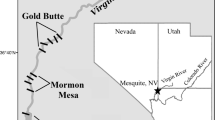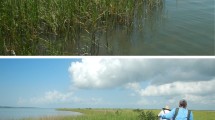Abstract
Non-native invasive plants are a significant threat to native biodiversity as they change community structure and ecosystem processes and it is becoming imperative that these invasive plants are controlled. We investigated the response of wetland invertebrates to glyphosate chemical control of an introduced tree, grey willow (Salix cinerea), in a before-after-control-impact (BACI) experiment within a New Zealand wetland. Our findings suggest that control of grey willow resulted in significant increases in the abundance of invertebrates within 2 years after herbicide application. Analysis of beetle communities revealed that the abundance and species richness of herbivorous and predacious beetles, the abundance of introduced species, and the species richness of native and introduced species were all significantly higher in the herbicide-treated plots than in the unsprayed plots. The composition of the beetle community separated into two clear groups—plots before spray/no spray and plots 1 and 2 years after herbicide application. We suggest that the beetle compositional changes were driven by complex changes in vegetation associated with the canopy collapse of grey willow trees and the initial influx of introduced plant species, predominantly weedy annuals and perennials, after willow control. Restoration via invasive plant control can promote the reestablishment of invertebrate communities typical of native wetlands, but their long-term sustainability is contingent on prevention of grey willow reinvasion and reestablishment of the native plant habitat.






Similar content being viewed by others
References
Beard C (2010) Wetlands and lowland floodplains. In: Collier KJ, Hamilton DP, Want WN, Howard-Williams C (eds) The waters of the Waikato. Ecology of New Zealand’s longest river. Environment Waikato and the Centre for Biodiversity and Ecology Research (The University of Waikato), Hamilton, pp 265–279
Beggs J (2001) The ecological consequences of social wasps (Vespula spp.) invading an ecosystem that has an abundant carbohydrate resource. Biol Conserv 99:17–28
Belbin L (1995) PATN: pattern analysis package. CSIRO Division of Wildlife and Ecology, Canberra
Bodmin KA, Champion PD (2010) Review of Whangamarino Wetland vegetation response to the willow control programme (1999–2008). NIWA client Report HAM 2010-010. National Institute of Water and Atmospheric Research Ltd, Hamilton, New Zealand, 73 p
Champion P (1994) Extent of willow invasion—the threats. In: West CJ (ed) Wild willows in New Zealand. Proceedings of a willow control workshop hosted by Waikato Conservancy, Hamilton. Department of Conservation, New Zealand, pp 43–49
Collier KJ (1994) Effects of willows in waterways and wetlands—an aquatic habitat perspective. In: West CJ (ed) Wild willows in New Zealand. Proceedings of a willow control workshop hosted by Waikato Conservancy, Hamilton. Department of Conservation, New Zealand, pp 33–41
Collins CM, Fellowes MDE, Sage RB, Leather SR (2001) Host selection and performance of the giant willow aphid, Tuberolachnus salignus Gmelin—implications for pest management. Agric For Entomol 3:183–189
Crisp PN, Dickinson KJM, Gibbs GW (1998) Does native invertebrate diversity reflect native plant diversity? A case study from New Zealand and implications for conservation. Biol Conserv 83:209–220
Davis ALV, Van Aarde RJ, Scholtz CH, Delport JH (2002) Increasing representation of localized dung beetles across a chronosequence of regenerating vegetation and natural dune forest in South Africa. Glob Ecol Biogeogr 11:191–209
Duggan K, Roberts L, Beech M, Robertson H, Brady M, Lake M, Jones K, Hutchinson K, Patterson S (2013) Arawai Kakariki wetland restoration. Research and Development Group, Department of Conservation, Wellington
ESRI (1999) ArcView 3.2. Environmental Systems Research Institute. ArcView GIS: Release 3.2 [software]. Environmental Systems Research Institute, 1992–1999, Redlands, California
Franz JE (1985) Discovery, development and chemistry of glyphosate. In: Grossbard E, Atkinson D (eds) The herbicide glyphosate. Butterworth, London, pp 3–15
Froude VA (2002) Biological control options for invasive weeds of New Zealand protected areas. Prepared for Department of Conservation, New Zealand, 68 p
Gerber E, Krebs C, Murrell C, Moretti M, Rocklin R, Schaffner U (2008) Exotic invasive knotweeds (Fallopia spp.) negatively affect native plant and invertebrate assemblages in European riparian habitats. Biol Conserv 141:646–654
Gerlach J, Samways M, Pryke J (2013) Terrestrial invertebrates as bioindicators: an overview of available taxonomic groups. J Insect Conserv 17:831–850
Gessner MO, Swan CM, Dang CK, McKie BG, Bardgett RD, Wall DH, Hattenschwiler S (2010) Diversity meets decomposition. Trends Ecol Evol 25:372–380
Gratton C, Denno RF (2005) Restoration of arthropod assemblages in a Spartina salt marsh following removal of the invasive plant Phragmites australis. Restor Ecol 13:358–372
Grégoire Taillefer A, Wheeler T (2012) Community assembly of Diptera following restoration of mined boreal bogs: taxonomic and functional diversity. J Insect Conserv 16:165–176
Grimbacher PS, Catterall CP (2007) How much do site age, habitat structure and spatial isolation influence the restoration of rainforest beetle species assemblages? Biol Conserv 135:107–118
Haddad NM, Tilman D, Haarstad J, Ritchie M, Knops JMH (2001) Contrasting effects of plant richness and composition on insect communities: a field experiment. Am Nat 158:17–35
Haddad NM, Crutsinger GM, Gross K, Haarstad J, Knops JMH, Tilman D (2009) Plant species loss decreases arthropod diversity and shifts trophic structure. Ecol Lett 12:1029–1039
Handa IT, Aerts R, Berendse F, Berg MP, Bruder A, Butenschoen O, Chauvet E, Gessner MO, Jabiol J, Makkonen M, McKie BG, Malmqvist B, Peeters E, Scheu S, Schmid B, van Ruijven J, Vos VCA, Hattenschwiler S (2014) Consequences of biodiversity loss for litter decomposition across biomes. Nature 509:218–221
Harman HM (2004) Feasibility of biological control of grey willow, Salix cinerea. DOC Science Internal Series 183. Department of Conservation, Wellington, New Zealand, 29 p
Hawes C, Haughton AJ, Osborne JL, Roy DB, Clark SJ, Perry JN, Rothery P, Bohan DA, Brooks DR, Champion GT, Dewar AM, Heard MS, Woiwod IP, Daniels RE, Young MW, Parish AM, Scott RJ, Firbank LG, Squire GR (2003) Responses of plants and invertebrate trophic groups to contrasting herbicide regimes in the Farm Scale Evaluations of genetically modified herbicide–tolerant crops. Philos Trans R Soc Lond B Biol Sci 358:1899–1913
Heads MJ, de Lange PJ (1999) Parsonia praeruptis (Apocynacaeae): a new threatened, ultramafic endemic from North Cape, New Zealand. N Z J Bot 37:1–6
Herrera AM, Dudley TL (2003) Reduction of riparian arthropod abundance and diversity as a consequence of giant reed (Arundo donax) invasion. Biol Invasions 5:167–177
Hulme PE, Bremner ET (2006) Assessing the impact of Impatiens glandulifera on riparian habitats: partitioning diversity components following species removal. J Appl Ecol 43:43–50
Hutcheson J (1990) Characterization of terrestrial insect communities using quantified, Malaise-trapped Coleoptera. Ecol Entomol 15:143–151
Hutcheson J, Jones D (1999) Spatial variability of insect communities in a homogenous system: measuring biodiversity using Malaise trapped beetles in a Pinus radiata plantation in New Zealand. For Ecol Manag 118:93–105
Hutcheson JA, Kimberley MO (1999) A pragmatic approach to characterising insect communities in New Zealand: Malaise trapped beetles. N Z J Ecol 23:69–79
Keane RM, Crawley MJ (2002) Exotic plant invasions and the enemy release hypothesis. Trends Ecol Evol 17:164–170
Klimaszewski J, Watts JC (1997) Coleoptera: family-group review and keys to identification. Fauna of New Zealand Number 37. Manaaki Whenua Press. Canterbury, New Zealand
Knops JMH, Tilman D, Haddad NM, Naeem S, Mitchell CE, Haarstad J, Ritchie ME, Howe KM, Reich PB, Siemann E, Groth J (1999) Effects of plant species richness on invasion dynamics, disease outbreaks, insect abundances and diversity. Ecol Lett 2:286–293
Kolpin DW, Thurman EM, Lee EA, Meyer MT, Furlong ET, Glassmeyer ST (2006) Urban contributions of glyphosate and its degradate AMPA to streams in the United States. Sci Total Environ 354:191–197
Kuschel G (1990) Beetles in a suburban environment: a New Zealand case study. DSIR Plant Protection report no. 3, Department of Scientific and Industrial Research, 118 p
Levine JM, Vila M, D’Antonio CM, Dukes JS, Grigulis K, Lavorel S (2003) Mechanisms underlying the impacts of exotic plant invasions. Proc R Soc B Biol Sci 270:775–781
Murphy DJ, Kelly D (2003) Seasonal variation in the honeydew, invertebrate, fruit and nectar resource for bellbirds in a New Zealand mountain beech forest. N Z J Ecol 27:11–23
Nakamura F, Yamada H (2005) Effects of pasture development on the ecological functions of riparian forests in Hokkaido in northern Japan. Ecol Eng 24:539–550
New TR (2010) Butterfly conservation in Australia: the importance of community participation. J Insect Conserv 14:305–311
Poyry J, Luoto M, Paukkunen J, Pykala J, Raatikainen K, Kuussaari M (2006) Different responses of plants and herbivore insects to a gradient of vegetation height: an indicator of the vertebrate grazing intensity and successional age. Oikos 115:401–412
Sopow S, Gresham B, Gunawardana D, Flynn A (2014) Tuberolachnus salignus, a new aphid on the block. Forest Health News 246. Newsletter of the Scion Forest Protection team, Rotorua, New Zealand
Standish RJ, Robertson AW, Williams PA (2001) The impact of an invasive weed Tradescantia fluminensis on native forest regeneration. J Appl Ecol 38:1253–1263
van Kraayennoord CWS, Slui B, Knowles FB (1995) Introduced forest trees in New Zealand, 15. The willows. Forest Research Institute Bulletin No. 124, New Zealand, 32 p
VSN International (2013) GenStat for windows, 16th edn. VSN International, Hemel Hempstead
Watts CH, Gibbs GW (2002) Revegetation and its effect on the ground-dwelling beetle fauna of Matiu-Somes Island, New Zealand. Restor Ecol 10:96–106
Watts CH, Clarkson BR, Didham RK (2008) Rapid beetle community convergence following experimental habitat restoration in a mined peat bog. Biol Conserv 141:568–579
Watts C, Rohan M, Thornburrow D (2012) Beetle community responses to grey willow (Salix cinerea) invasion within three New Zealand wetlands. N Z J Zool 39:209–227
Wilkinson AG (1999) Poplars and willows for soil erosion control in New Zealand. Biomass Bioenergy 16:263–274
Acknowledgments
This research was supported by the Ministry of Business, Innovation and Employment, under contract CO9X1002 and CoRE funding. We thank Joshua Ormsby and Jonathan Brown for assistance in the field. Chris Winks provided advice on beetle interactions with introduced annuals and perennials. Anne Austin and William Lee provided helpful comments on this manuscript.
Author information
Authors and Affiliations
Corresponding author
Additional information
Handling Editor: Rupesh Kariyat.
Rights and permissions
About this article
Cite this article
Watts, C., Ranson, H., Thorpe, S. et al. Invertebrate community turnover following control of an invasive weed. Arthropod-Plant Interactions 9, 585–597 (2015). https://doi.org/10.1007/s11829-015-9396-6
Received:
Accepted:
Published:
Issue Date:
DOI: https://doi.org/10.1007/s11829-015-9396-6




